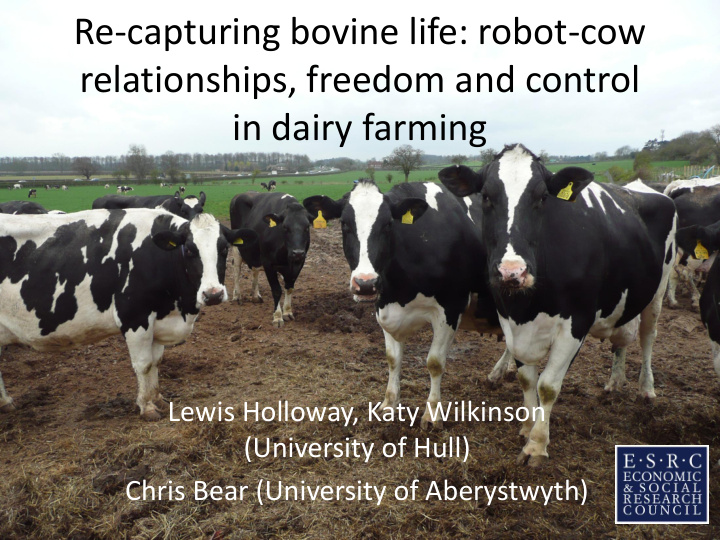



Re-capturing bovine life: robot-cow relationships, freedom and control in dairy farming Lewis Holloway, Katy Wilkinson (University of Hull) Chris Bear (University of Aberystwyth)
Introduction: re-capturing bovine life • Aim of the paper: To examine the interplay between notions and practices of bovine freedom and control in robotic milking systems.
Paper outline • What is robotic milking? • Foucault and farm animals • Research methods. • Empirical themes: 1. how is ‘bovine freedom’ framed by manufacturers and farmers? 2. what new power-knowledge relations are made possible by the design of robotic technologies? 3. how are cows disciplined and subjectified in robotic milking systems? • Conclusions
What is robotic milking?
Foucault and farm animals 1. Discipline: intensive agriculture and the control of animal bodies 2. Biopower: technological interventions and the fostering of animal life • Subjectification, truth picture discourses and care 3. Constituting bovine subjectivity and human-animal-technology relations
Research methods – 24 farmer interviews and 3 in depth case studies – further 27 interviews (manufacturers, scientists, welfare bodies, vets etc.) – Visual methods and observation
Framing bovine freedom in robotic milking - 1 ‘In any robotic system the cows are left to their own devices. They do what they picture want ... The cow takes control of her own destiny’ (manufacturer A) ‘The cows are very much free to do their own thing ... You just let them get on with the job really’ (farmer A)
Framing bovine freedom in robotic milking - 2 ‘It’s maybe just they’re happier because they do seem genuinely happy, they’re free range cows, as opposed picture to they’ve been managed and driven round’ (farmer B) ‘you let them get on with the job really, it’s up to you to provide for them, your whole mindset has to be providing for those animals and helping them achieve what they can do without forcing them’ (farmer A)
Robotic technologies and new power- knowledge relations - 1 ‘you gain access to a level of knowledge and control unheard of until now. Your cows can no longer hold any secrets from you!’ ( DeLaval website, August 2011) ‘I think with robotics you’re looking at management by exception ... The data you can, let’s say pull off the cow, i.e. Yield, activity, and start collating that information it allows you to manage and fine tune the animals you know accordingly which then brings the efficiencies into play of the feed’ (manufacturer B)
Robotic technologies and new power- knowledge relations - 2 ‘Now each cow’s biology is different ... So the system will know how long and how much milk each cow will give so when she comes to this gate the choice is made accurately whether or not she needs to go to the milking station. And that prevents crowding in the waiting area, and also means you get a good spread of animals throughout the barn’ (manufacturer A)
Robots, discipline and subjectification - 1 ‘I think the most important thing is getting the cow correct ... Not just her mobility but actually her health status, her rumen correct, get her actually as healthy as can be ... You’ve got to have these cows happy and healthy and looking for feed ... You’ve got to have something to drive that cow; you’ve got to think differently, how am I going to entice this cow to the feed fence? How am I going to entice this cow to the milking station’ (farmer C)
Robots, discipline and subjectification - 2 ‘they’re tricking their cows to milk them, it’s not really voluntary. At the end of the day the cow has to be milked, if she’s not going to milk then she’s not going to make it as a dairy cow’ (farmer D) ‘we have cows that are lazy cows that only want to go and get milked once a day that just lie there all day. Well you know they’re no use for a robotic system so, but we’re slowly but surely weeding them out’ (farmer C)
Robots, discipline and subjectification - 3 ‘The cows do have their own individual routines and they know they can’t get away with not being milked. For example [my wife] will often see from the computer in the morning that 56 and 31 have not been milked but by the time she gets into the shed they are already at the robot because they know it is their turn’ (farmer E)
Conclusions 1. “Successful robotic milking is a new style of farm management whereby the decisions are transferred from the farmer to the cow.”? (Lely website, August 2011) 2. Countering the idea of ‘freedom’, robotic milking demands the fostering and re-enclosure of bovine life. 3. ‘Cow space’ is designed to regulate behaviour and ensure cows make the ‘right’ choices and develop an appropriate ‘regime of care’ 4. Dairy farm biosocial collectivities and a distributed sense of ‘care’: bovine ‘freedom’ becomes a co -responsibility to take care/be taken care of in human-nonhuman relationships and to foster productive life
Recommend
More recommend